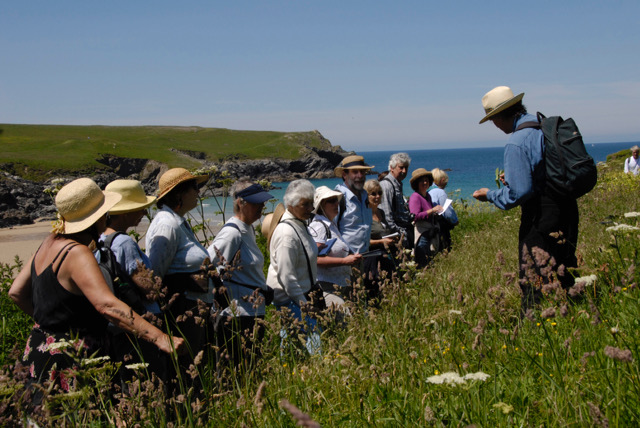Allium ampeloprasum var babingtonii – Babington’s Leek
I was first introduced to this enchanting plant on a Botany Walk with Keith Spurgin on the Cornish North Coast. Keith is an Emeritus Recorder for the Botanical Society of Britain and Ireland, and passionate about his subject. A Fellow of the Linnean Society, a plant scientist, flora writer, and an expert on brambles, Keith leads the Eden Project Florilegium Society on an annual walk in different locations around Cornwall. He drew our attention to this rather quirky variation of a wild Leek, and it brought a smile to my face!

Babington’s Leek is a Cornish speciality, and named after Charles Cardale Babington who lived at the same time as Charles Darwin. It grows wild and is found on rocks and dunes near the sea. To quote Keith, who has been recording this plant for over forty years, ” It has thrived! At the top of a very long stem small bulbs grow and are scattered to form new colonies. There is a snake’s head bend in the stem early on, but later it straightens and grows its “crazy hair ” flowers, it is both edible and ornamental.” It was the “crazy hair” look that enchanted me, and I have always wanted to paint it.

When the call came to paint a native plant I immediately thought of the Babington’s Leek. It is not one of the well known or easily recognisable native plants, but I thought it deserved a wider audience.
I rang Keith for his advice on where to find a plant, and who I could ask to take away any plant material. Keith happily announced that he loved it so much he grew it in his garden! So he generously gave me some bulbs to plant and a couple of pots of the Leek in the early stages of growth.
Keith lives in the centre of Truro, and brandishing a garden fork offered to walk with me back to the Marks and Spencer’s Car Park. As we arrived at the back of the building he proceeded to dig up a large plant from a flower bed, much to my surprise and consternation! He explained that he had personally planted them, so he felt he had every right to dig one up again. I am sure many shoppers walk past, and never appreciate the wild flowers, especially rare ones, growing in the centre of town, under their noses!
I now had plenty of material to take back to my studio to grow on and time to study.
Firstly I painted several of the bulbs while waiting for the planted ones to grow. The dried bulbs were papery white and the dried leaves golden and crisp.

As the plant grew, I realised that the main challenge would be one of composition. The stout stem, bearing the irregular umbel of mauve flowers and bulbils grows tall. The leaves are keeled and tend to wither as the flowerhead matures, turning golden and then fading to pale creamy grey. The flower bud, a round cluster of flowers and bulbils, is encased in a papery sheath with a long pointed tip.
I initially drew the whole plant on mapping paper. A tall and elegant image with drooping, twisting and fading leaves, typical of the Allium family presented itself. Obviously the painting would be very tall and thin if I just painted that. It was tempting! I have always admired Coral Guest’s spectacular painting of Lilium Regale, the entire plant on one enormous piece of paper. However at only 5′ tall, I knew I would struggle to reach parts to paint in detail.

At that time I heard the very sad news that one of this country’s greatest Botanical Artists, Pandora Sellars, had died. I was showing some of my students examples of her work, reflecting on her brilliance in cropping and layering her subjects, and her mastery of composition, and determined to learn from her.
I drew and traced every element of the plant, and by arranging and rearranging them, I was able to include as much of it as possible. The deciding factor was that I was given a sheet of “old” Fabriano!
If you are walking on the coast path of Cornwall, do look out for this rare and unusual native plant and I hope it’s crazy hair appearance makes you smile.

It is important that some of our rarer native plants are recognised by the wider public, so that they can be protected and preserved for future generations.
